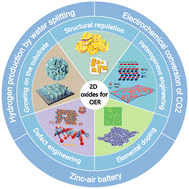Two dimensional oxides for oxygen evolution reactions and related device applications
Abstract
The oxygen evolution reaction (OER) is a key anode reaction for many renewable energy devices, such as electrocatalytic water splitting devices, Zn–air batteries and CO2 electrolyzers. Transition metal oxides have been broadly explored for the OER due to their good electrochemical stability and low cost. However, their generic catalytic performance and poor electrical conductivity have greatly impeded their practical applications. Fabricating oxides into two dimensional (2D) structures can increase their surface areas and modulate the electronic structures of their catalytic sites, which is a new method to improve the OER performance. However, 2D oxides still come across some challenges for the OER, such as easy restacking of the 2D materials, poor intrinsic activity of the transition metal atoms and difficulty in their mass production. In this review, we firstly introduce the background and importance of the OER. Then, the OER mechanism and strategies to optimize the OER performance for 2D oxides are thoroughly reviewed. Their initial explorations in water splitting, Zn–air battery and CO2 electrolyzer applications have also been considered. Finally, the current challenges and future opportunities in the synthesis and applications of 2D oxides are clearly highlighted.

- This article is part of the themed collections: 2023 Materials Chemistry Frontiers Review-type Articles and 2023 Materials Chemistry Frontiers HOT articles


 Please wait while we load your content...
Please wait while we load your content...